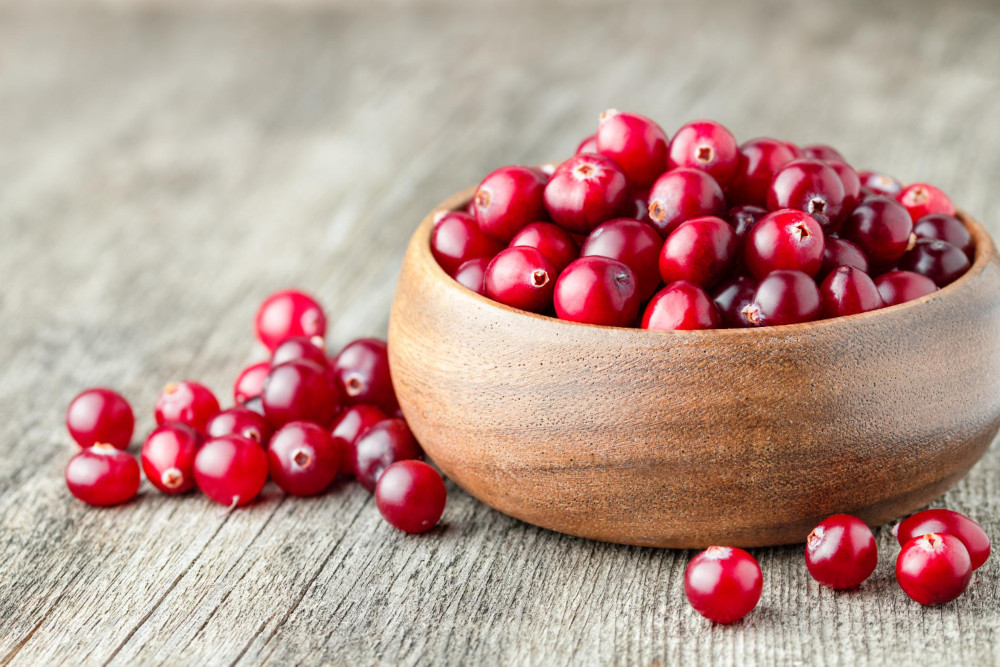Cranberry - health-promoting properties hidden in small, red fruits

Cranberry is a plant that has been used in medicine and herbal medicine for centuries. It exhibits a number of health-promoting properties, and is best known for its antibacterial effect in urinary tract infections.
Cranberry fruits are rich in many valuable compounds, including vitamin C or flavonoids. It is thanks to the content of these substances that the fruits of the plant can have a positive effect on the human body and support it in its proper daily functioning.
Cranberry - what is it?
The cranberry belongs to the heather family, and its most common variety is the large-fruited cranberry, originating from North America. It is a perennial plant whose fruits, in the form of small red balls, look like berries.
Cranberry fruits are distinguished by their tart and sour taste, but they are a wealth of valuable substances and nutrients.

Cranberry - what is hidden in its fruits?
Red, inconspicuous balls of cranberries are a wealth of dietary fiber, as well as vitamins and minerals, among others:
- calcium,
- iron,
- magnesium,
- B vitamins,
- vitamin C,
- vitamin E.
It is also a treasure trove of bioactive plant compounds and antioxidants, most notably polyphenols. In cranberries there are, among others:
- quercetin,
- myricetin,
- peonidine,
- ursolic acid,
- proanthocyanidins.
Interestingly, many of the nutritional compounds are found mainly in the skin of the cranberry fruit. Thus, the amount of bioactive substances in cranberry juice, for example, can be significantly reduced.
Health-promoting properties of cranberries
The component of cranberry with health-promoting properties is its fruit, and all the "power" of the plant is due to the presence of compounds such as flavonoids, anthocyanins, proanthocyanidins or organic acids.
Cranberry and oxidative stress
Due to the presence of flavonoids, especially quercetin and myricetin, cranberry can act as antioxidants and support fight against free radicals. The fruit of the plant may also promote the reduction of oxidative stress.
Cranberry and the urinary tract
Cranberry fruit is commonly used in supporting the fight against urinary tract infections. Cranberries may exhibit antibacterial properties, especially against bacteria responsible for urinary tract infections. Then the substances contained in the cranberry can acidify the urine, inhibit the multiplication of bacteria and block their adhesion to the mucous membranes of the urinary tract.
Prophylactic use of cranberries can also help reduce the frequency of recurrent urinary tract infections. In addition, the fruits of the plant have a diuretic effect and can speed up getting rid of bacteria from the body.
Recommended products
Cranberry and the cardiovascular system
The substances contained in cranberry fruit, including flavonoids, can act to inhibit the formation of blood clots, and also contribute to the dilation of blood vessels. Thus, cranberry may reduce the risk of cardiovascular problems and may reduce blood pressure.
As if that were not enough, the numerous antioxidants present in the fruit of the plant can prevent the oxidation of cholesterol, and thus positively affect and protect the vessels.
Cranberry and the respiratory system
Cranberry can also act as a supportive agent for upper respiratory tract infections, and what's more, it can exhibit anti-inflammatory and antiseptic effects on the mouth and throat and help fight colds and flu. Its strengthening effect on the body may be due, among other things, to its high content of vitamin C.
Other properties of cranberry
Cranberry can also be used in the treatment of gastric ulcer disease. Due to the presence of proanthocyanidins and tannins, it can reduce or inhibit the "attachment" of pathogenic bacteria to gastric epithelial cells.
Fresh or dried cranberries?
Fresh or dried cranberries? That is the question! So we are already in a hurry to answer it!
The process of drying cranberries contributes to the concentration of sugar contained in the fruit, which increases the content of simple sugars and reduces the level of water and dietary fiber.
Although both fresh and dried cranberries are a wealth of valuable nutrients, unprocessed cranberries have far more of them, and drying the fruit of the plant contributes to reducing the antioxidants it contains.
What is equally interesting, fresh cranberries contain as much as 90% of water, and 100 g of fruit has only 46 kcal. In turn, 100 g of dried cranberries contain as much as 330 kcal.
Thus, fresh cranberries are a product that can be successfully used on a reduction diet. Due to the richness in fiber, raw cranberries can help satisfy hunger and provide a feeling of satiety. However, its dried version, consumed uncontrollably, due to its high energy content and higher content of simple sugars, is no longer a welcome ingredient in the diet of people who want to get rid of unnecessary kilograms.
So it can be said that fresh cranberries are definitely a better choice. However, its tart, sour taste makes it difficult to consume without problems. So it is worth using fresh cranberries as an addition to various dishes or baked goods such as oatmeal, smoothie or meat. Supplying cranberry fruit to the body in the form of tea, juice or a dietary supplement in tablets can also be a good solution.
A portion of cranberry in your daily diet
The appropriate daily portion of cranberries that can positively affect the health and work of the body depends, of course, on the form and type of product chosen.
Many scientific studies that have confirmed the positive health effects of fresh cranberries have used 100 to 400 mg of the product per day. In terms of dried fruit, that's 7 to 10 g each day.
It is worth keeping common sense when using cranberries. Particular caution should be taken by people with blood clotting problems, using warfarin. Cranberry can then reduce blood clotting.
Also, people suffering from calcium deficiency should be vigilant, as cranberries contain oxalates, and these can interfere with the absorption of calcium from consumed food.

